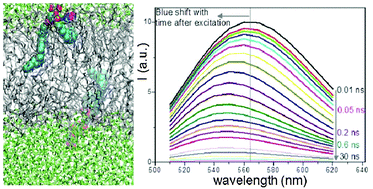Fluorescence of nitrobenzoxadiazole (NBD)-labeled lipids in model membranes is connected not to lipid mobility but to probe location†
Abstract
Nitrobenzoxadiazole (NBD)-labeled lipids are popular fluorescent membrane probes. However, the understanding of important aspects of the photophysics of NBD remains incomplete, including the observed shift in the emission spectrum of NBD-lipids to longer wavelengths following excitation at the red edge of the absorption spectrum (red-edge excitation shift or REES). REES of NBD-lipids in membrane environments has been previously interpreted as reflecting restricted mobility of solvent surrounding the fluorophore. However, this requires a large change in the dipole moment (Δμ) of NBD upon excitation. Previous calculations of the value of Δμ of NBD in the literature have been carried out using outdated semi-empirical methods, leading to conflicting values. Using up-to-date density functional theory methods, we recalculated the value of Δμ and verified that it is rather small (∼2 D). Fluorescence measurements confirmed that the value of REES is ∼16 nm for 1,2-dioleoyl-sn-glycero-3-phospho-L-serine-N-(NBD) (NBD-PS) in dioleoylphosphatidylcholine vesicles. However, the observed shift is independent of both the temperature and the presence of cholesterol and is therefore insensitive to the mobility and hydration of the membrane. Moreover, red-edge excitation leads to an increased contribution of the decay component with a shorter lifetime, whereas time-resolved emission spectra of NBD-PS displayed an atypical blue shift following excitation. This excludes restrictions to solvent relaxation as the cause of the measured REES and TRES of NBD, pointing instead to the heterogeneous transverse location of probes as the origin of these effects. The latter hypothesis was confirmed by molecular dynamics simulations, from which the calculated heterogeneity of the hydration and location of NBD correlated with the measured fluorescence lifetimes/REES. Globally, our combination of theoretical and experiment-based techniques has led to a considerably improved understanding of the photophysics of NBD and a reinterpretation of its REES in particular.


 Please wait while we load your content...
Please wait while we load your content...